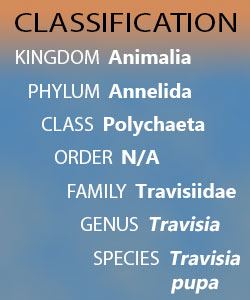
Compared to most of the tiny mud-dwelling invertebrates in Puget Sound, this month’s critter, the Pacific Stinkworm, is a giant — and it has a gigantic stench to match.
Vampire-free zone
Travisia pupa may look unassuming, but like other species of marine segmented worms in its genus, it has a hidden talent that will knock your socks off. When disturbed, the stinkworm, as its name suggests, gives off a pungent odor similar to rotting garlic.
Our scientists recently witnessed this firsthand while sampling the sediments in Admiralty Inlet. We immediately knew we had scooped up a stinkworm because of the terrible stink it emitted as the benthic grab landed on the deck of the boat. It certainly does the trick as a human (or vampire) repellent!
Although this pungent phenomenon is not well-studied, it is generally thought to be a chemical defense mechanism used to deter predators. There has also been speculation by scientists that the smell is a byproduct of microbial fermentation in the gut of Travisia — that is, the worms use symbiotic bacteria in their digestive systems to help obtain nutrients from their food.
A great face for radio
Travisia pupa is conspicuous on muddy ocean bottoms from Alaska to Mexico, growing to the whopping size of 8 cm long (a little over 3 inches) and 3 cm wide. With its fat, grub-like body and covering of wart-like vesicles, it’s not likely to win any beauty contests, but we think it might qualify for Miss Congeniality.
Close-up of the underside of the head, showing the mouth.
Warts and all
LEFT: Live Travisia pupa, ventral
Critter of the Month
Our benthic taxonomists, Dany and Angela, are scientists who identify and count the benthic (sediment-dwelling) organisms in our samples as part of our Marine Sediment Monitoring Program. We track the numbers and types of species we see in order to understand the health of Puget Sound and detect changes over time.
Dany and Angela share their discoveries by bringing us a Benthic Critter of the Month. These posts will give you a peek into the life of Puget Sound’s least-known inhabitants. We’ll share details on identification, habitat, life history, and the role each critter plays in the sediment community. Can't get enough benthos? See photos from our Eyes Under Puget Sound collection on Flickr.




